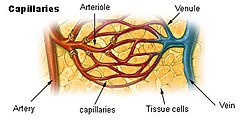Difference between revisions of "AY Honors/Heart and Circulation/Answer Key"
| Line 1: | Line 1: | ||
{{honor header|1|2006|Health and Science|North American Division}} | {{honor header|1|2006|Health and Science|North American Division}} | ||
==1. Describe the basic function of the following parts of the circulatory system: heart, blood vessels, blood, and lungs.== | ==1. Describe the basic function of the following parts of the circulatory system: heart, blood vessels, blood, and lungs.== | ||
| + | ;Heart: The heart is a muscular organ responsible for pumping blood through the blood vessels. | ||
| + | ;Blood Vessels: The blood vessels are like tubes inside the body though which blood flows. They function to transport blood throughout the body. | ||
| + | ;Blood: Blood is a specialized fluid consisting of red blood cells, white blood cells, and platelets suspended in a complex fluid medium known as blood plasma. Blood plasma is the liquid component of blood, in which the blood cells are suspended. It makes up a little more than half of total blood volume. By far the most abundant cells in blood are red blood cells. Red blood cells carry oxygen to all the other cells in the body and carry carbon dioxide (and other wastes) away from them. White blood cells help to resist infections, and platelets are important in the clotting of blood. | ||
| + | ;Lungs: The principal function of the lungs is to transport oxygen from the atmosphere into the bloodstream, and to get rid of carbon dioxide from the bloodstream into the atmosphere. | ||
| + | |||
==2. Describe the major difference between arteries and veins. What is a capillary and what is its function?== | ==2. Describe the major difference between arteries and veins. What is a capillary and what is its function?== | ||
[[Image:Illu capillary.jpg|thumb|250px|Blood flows from digestive system heart to arteries, which narrow into arterioles, and then narrow further still into capillaries. After the tissue has been perfused, capillaries widen to become venules and then widen more to become veins, which return blood to the heart.]] | [[Image:Illu capillary.jpg|thumb|250px|Blood flows from digestive system heart to arteries, which narrow into arterioles, and then narrow further still into capillaries. After the tissue has been perfused, capillaries widen to become venules and then widen more to become veins, which return blood to the heart.]] | ||
Revision as of 16:37, 24 October 2007
1. Describe the basic function of the following parts of the circulatory system: heart, blood vessels, blood, and lungs.
- Heart
- The heart is a muscular organ responsible for pumping blood through the blood vessels.
- Blood Vessels
- The blood vessels are like tubes inside the body though which blood flows. They function to transport blood throughout the body.
- Blood
- Blood is a specialized fluid consisting of red blood cells, white blood cells, and platelets suspended in a complex fluid medium known as blood plasma. Blood plasma is the liquid component of blood, in which the blood cells are suspended. It makes up a little more than half of total blood volume. By far the most abundant cells in blood are red blood cells. Red blood cells carry oxygen to all the other cells in the body and carry carbon dioxide (and other wastes) away from them. White blood cells help to resist infections, and platelets are important in the clotting of blood.
- Lungs
- The principal function of the lungs is to transport oxygen from the atmosphere into the bloodstream, and to get rid of carbon dioxide from the bloodstream into the atmosphere.
2. Describe the major difference between arteries and veins. What is a capillary and what is its function?
Arteries are muscular blood vessels that carry blood away from the heart. All arteries, with the exception of the pulmonary and umbilical arteries, carry oxygenated blood.
Veins are blood vessels that carry blood toward the heart. The majority of veins in the body carry low-oxygen blood from the tissues back to the heart; the exceptions being the pulmonary and umbilical veins which both carry oxygenated blood.
Capillaries are the smallest of a body's blood vessels, measuring 5-10 μm, and are important for the interchange of oxygen, carbon dioxide, and other substances between blood and tissue cells. The walls of capillaries are composed of only a single layer of cells, the endothelium. This layer is so thin that molecules such as oxygen, water and lipids can pass through them by diffusion and enter the tissues. Waste products such as carbon dioxide and urea can diffuse back into the blood to be carried away for removal from the body. Capillaries are so small the blood cells need to pass through it in a single file line. Capillaries carry blood from the arteries to the veins.

